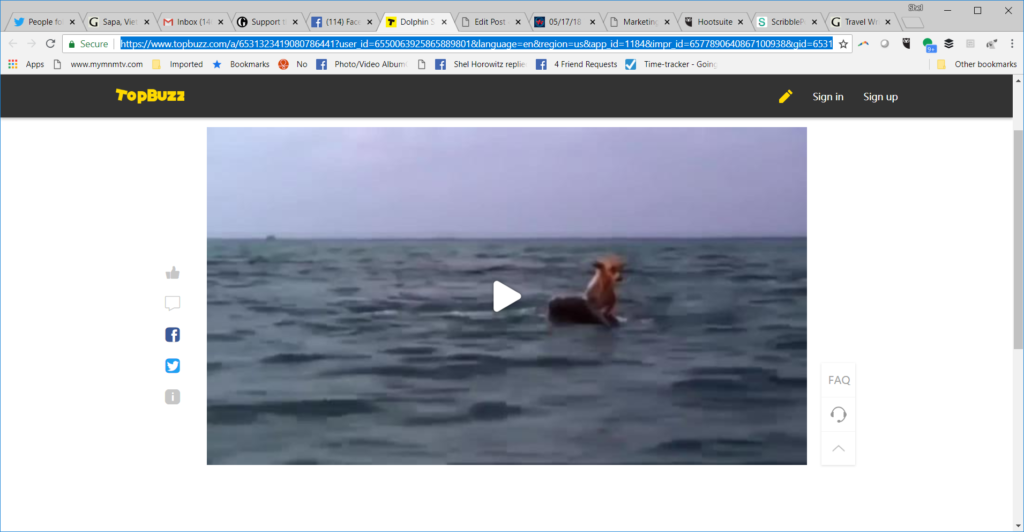What Is This Feel-Good Video Really About? (Part 2 of 2)
In Part 1 of this post, I shared a video of a dolphin rescuing a dog, asked whether you thought it was real or fake, and then told you my answer, with seven reasons why. If you missed it, please click on this paragraph to read it.
Why This Matters: A Metaphor for Something Much Deeper
Why am I going on about this? Why does it matter? Isn’t it just some people having fun making a feel-good film?
Answer: I do marketing and strategic profitability consulting for green and social change organizations, as well as for authors and publishers–and I’m also a lifelong activist. This combination of activism and marketing gives me another set of lenses to filter things, as well as a magnificent toolkit to make the world better. My activism also brings a strong sense of ethics into the marketing side.
Both as a marketer and an activist, I pay careful attention to how we motivate people to take action–to the psychology of messaging, One category for this post is psychology; click on that category to get posts going back many years. I worry deeply about our tendency as a society to crowd out facts with emotions. (I also worry about another tendency, to crowd out emotions with facts, but that’s a different post.)
And this is an example of crowding out facts with emotion. While this particular instance is innocuous as far as I can tell, we see examples of overreach on both the left and right, and they work to push us apart from each other, talk at each other instead of seeking common ground, and push real solutions farther and farther out of reach.
My inbox is full of scare-tactic emails from progressive, environmental, or Democratic Party organizations. Because I’m in the biz and understand what they’re doing, I leave most of them unopened. I just searched my unread emails for subject lines that contain the word “Breaking” and came with hundreds, including this one from a group called Win Without War:
Subject: Breaking: Trump ordered tanks in D.C.
From this subject line, you’d expect some horror story about peaceful protestors facing American military might. It could happen. It has happened in the past–for example, the 1970 Kent State massacre that left four Vietnam War protesters dead and nine more injured by Ohio National Guard soldiers’ bullets. (The shootings at Jackson State College in Mississippi 11 days later were committed by police, not soldiers.) And protestors in countries with totalitarian governments have often faced tanks; if you want to see courage, watch the video of a man stopping tanks with only a flag, in Beijing’s Tiananmen Square in 1989–WOW!)

It’s a clear attempt to generate hysteria, to have people perceiving tanks in the streets with their guns pointed at dissenters.
Only in the body of the email do we find out what’s really going on:
Shel —
Last night, the Washington Post broke the story that Donald Trump has ordered a giant military parade with tanks, guns, and troops taking over the streets of our nation’s capital. [1] This is the kind of parade that dictators around the world use to intimidate their enemies and, more importantly, their own citizens.
This is what authoritarian dictatorships look like.
But Trump can’t change the fact that we still live in a democracy — which means Washington, D.C.’s local government gets to have a say before Donald Trump’s tanks roll down its streets.
Note the use of mail merge software to appear personal. Does that really fool anybody anymore? But OK, even when you know it’s a mail merge, it still generates at least a small warm fuzzy.
More importantly, note that the actual content is totally different from the expectation in the headline. We can argue the foolishness of Trump wanting a military parade (I think it’s foolish, and an expensive attempt to stroke his ego)–but in no way is this the same as attacking demonstrators in the streets of Washington, DC.
The right wing is at least as bad. I don’t subscribe to their e-blasts, but I found this juicy example (with an introduction and then a rebuttal by the site hosting this post) in about ten seconds of searching.
And then there are DT’s own Tweets, news conferences, and speeches, both during the campaign and since he took the oath to uphold the constitution as President of the United States (an oath he has been in violation of every single day of his term). They are full of lies, misrepresentations, name-calling, bullying, and fear-mongering. They are hate speech. I will not give them legitimacy by quoting them here; they’re easy enough to find.
As a country, we are better than this..
How You Can “Vaccinate” Yourself Against Sensationalist Fear-mongering
Before sharing any news story or meme, run through a series of questions to help you identify if it’s real.And if it passes that test, pop on rumor-checking site Snopes and check its status. For that matter, go through a similar questions for advertising claims.
The questions will vary by the situation. Here are a few to get you started:
- Does the post link to documentation? Are most of the linked sites reputable? If they advance a specific agenda, does the post disclose this? (Note that THIS post links to several reputable sites, including NPR, New York Times, history.com, Wikipedia, Youtube, Google, CNN, Snopes, and my own goingbeyondsustainability.com and greenandprofitable.com. Yes, I am aware of the issues in using Wikipedia or Youtube as the only source. I am also aware that Google gives them a tremendous amount of “link juice” because on the whole, they are considered authoritative. For both those citations, I had plenty of documentation from major news sites.) Strong documentation linking to known and respected sources is a sign to take the post seriously.
- Does the post name-drop without specifics? See how the Win Without War letter mentions the Washington Post but leaves out the link? Remember that ancient email hoax citing longtime NPR reporter Nina Totenberg? Name-dropping to buy unsusbstantiated respect is not a good sign.
- Are the language and tone calm and rational, or screaming and sensationalist or even salacious?
- Is the post attributed? Can you easily contact the creator?
- And last but far from least, the most important question: Who benefits from the post’s point of view ? What are their relationships to the post’s creator? (Hello, Russian trollbots!). Don’t just follow the money. Follow the power dynamics, too.
I could go on but you get the idea. Please share your reactions in the comments.

